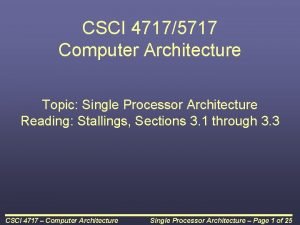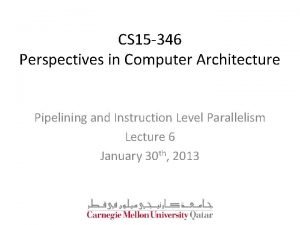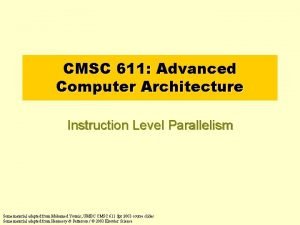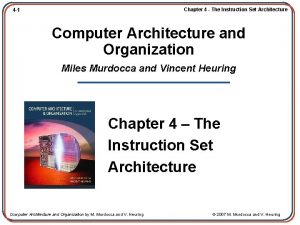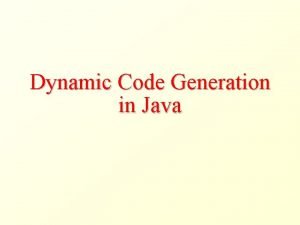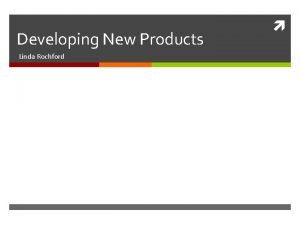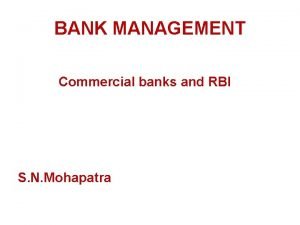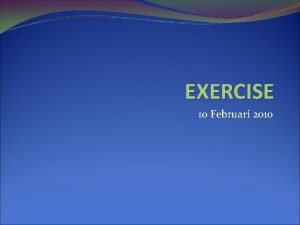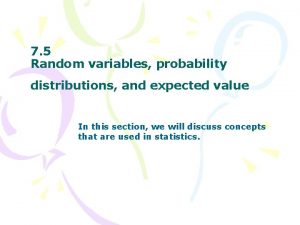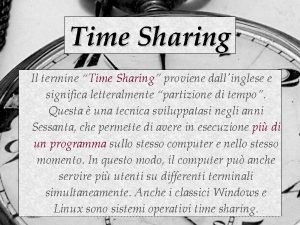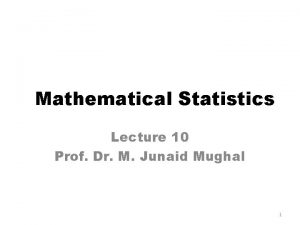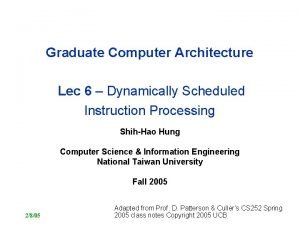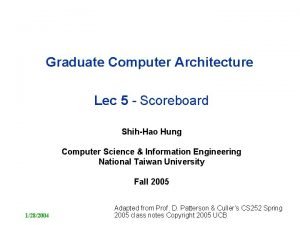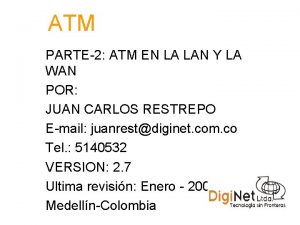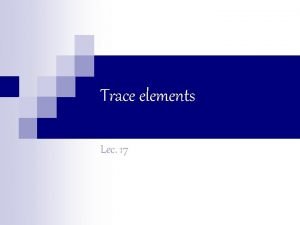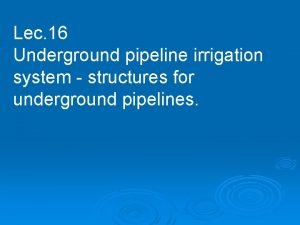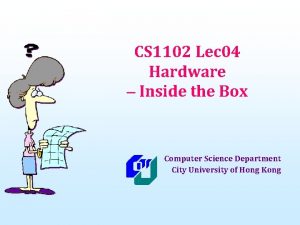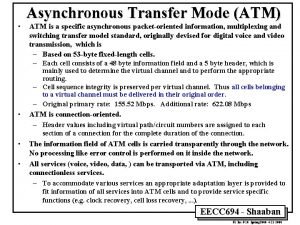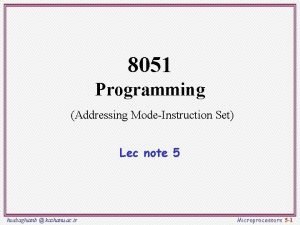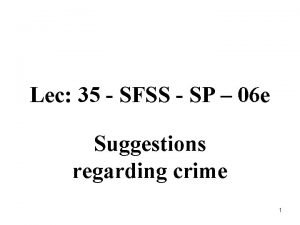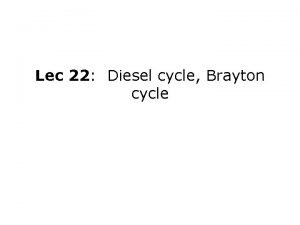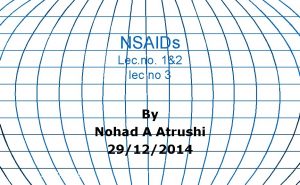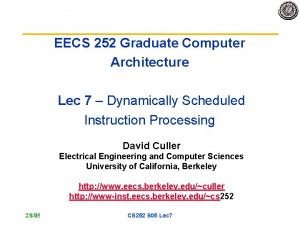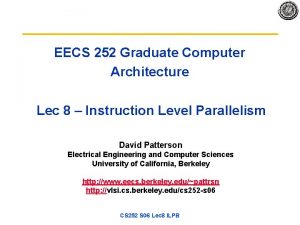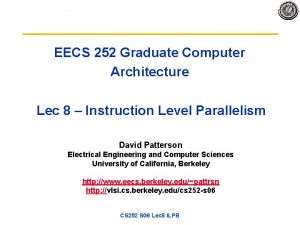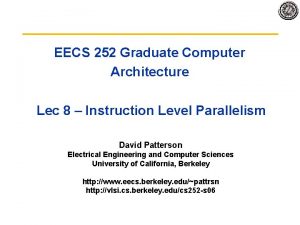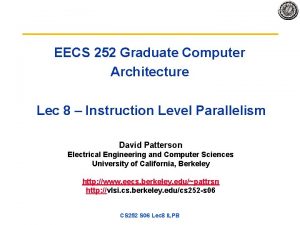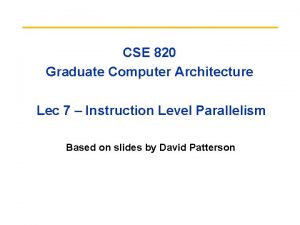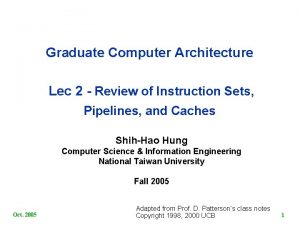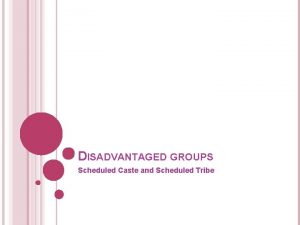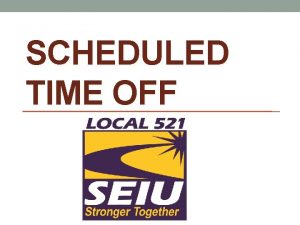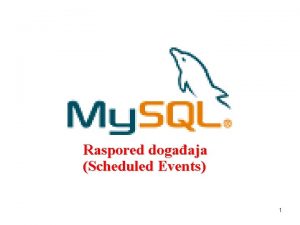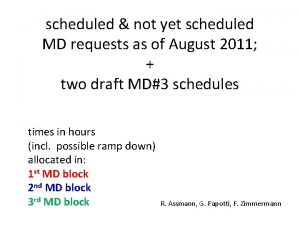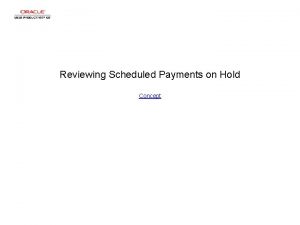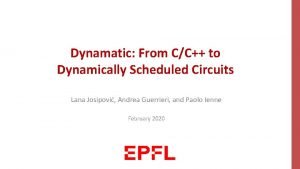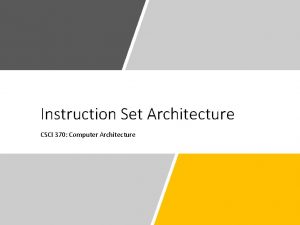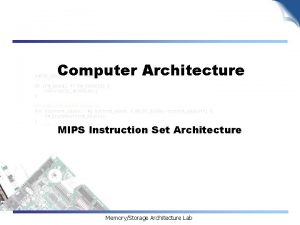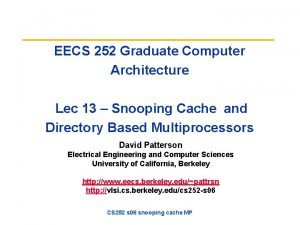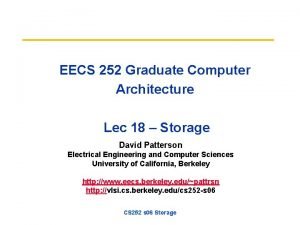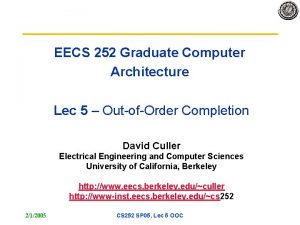Graduate Computer Architecture Lec 6 Dynamically Scheduled Instruction











![Reg renaming • Source Reg s: ifetch – physical reg P=R[s] • Destination reg Reg renaming • Source Reg s: ifetch – physical reg P=R[s] • Destination reg](https://slidetodoc.com/presentation_image_h/2639397ebdab473aaba3894fc8e30f5f/image-12.jpg)




































- Slides: 48

Graduate Computer Architecture Lec 6 – Dynamically Scheduled Instruction Processing Shih-Hao Hung Computer Science & Information Engineering National Taiwan University Fall 2005 2/8/05 Adapted from Prof. D. Patterson & Culler’s CS 252 Spring 2005 class notes Copyright 2005 UCB

What stops instruction issue? Creation of a new binding 2/8/05 Instr. Fetch Issue & Resolve op fetch Scoreboard Add r 1 : = r 2 + r 3 Add r 2 : = r 2 + 4 Lod r 5 : = mem[r 1+16] Lod r 6 : = mem[r 1+32] Mul r 7 : = r 5 * r 6 Bnz r 1, foo Sub r 7 : = r 0 – r 0 … : = r 7 FU op fetch ex 2

Review: Software Pipelining Example After: Software Pipelined 1 2 3 4 5 • Symbolic Loop Unrolling SD ADDD LD SUBI BNEZ 0(R 1), F 4 ; Stores M[i] F 4, F 0, F 2 ; Adds to M[i-1] F 0, -16(R 1); Loads M[i-2] R 1, #8 R 1, LOOP overlapped ops Before: Unrolled 3 times 1 LD F 0, 0(R 1) 2 ADDD F 4, F 0, F 2 3 SD 0(R 1), F 4 4 LD F 6, -8(R 1) 5 ADDD F 8, F 6, F 2 6 SD -8(R 1), F 8 7 LD F 10, -16(R 1) 8 ADDD F 12, F 10, F 2 9 SD -16(R 1), F 12 10 SUBI R 1, #24 11 BNEZ R 1, LOOP SW Pipeline Time Loop Unrolled – Maximize result-use distance – Less code space than unrolling Time – Fill & drain pipe only once per loop vs. once per each unrolled iteration in loop unrolling 5 cycles per iteration 2/8/05 3

Can we use HW to get CPI closer to 1? • Why in HW at run time? – Works when can’t know real dependence at compile time – Compiler simpler – Code for one machine runs well on another • Key idea: Allow instructions behind stall to proceed DIVD ADDD SUBD F 0, F 2, F 4 F 10, F 8 F 12, F 8, F 14 • Out-of-order execution => out-of-order completion. 2/8/05 4

Problems? • How do we prevent WAR and WAW hazards? • How do we deal with variable latency? – Forwarding for RAW hazards harder. RAW WAR 2/8/05 5

Scoreboard Implications • Out-of-order completion => WAR, WAW hazards? • Solutions for WAR: – Stall writeback until registers have been read – Read registers only during Read Operands stage • Solution for WAW: – Detect hazard and stall issue of new instruction until other instruction completes • No register renaming! • Need to have multiple instructions in execution phase => multiple execution units or pipelined execution units • Scoreboard keeps track of dependencies between instructions that have already issued. • Scoreboard replaces ID, EX, WB with 4 stages 2/8/05 6

Missing the boat on loops 1 Loop: LD F 0, 0(R 1) 2 stall 3 ADDD F 4, F 0, F 2 4 SUBI R 1, 8 5 BNEZ R 1, Loop 6 SD 8(R 1), F 4 ; delayed branch ; altered when move past SUBI • Even if all loop iterations independent – Recursion on the iteration variable – Output dependence and anti-dependence with each dest register • All iterations use the same register names! 2/8/05 7

What do registers offer? • Short, absolute name for a recently computed (or frequently used) value • Fast, high bandwidth storage in the datapath • Means of broadcasting a computed value to set of instructions that use the value – Later in time or spread out in space… 2/8/05 8

Another Dynamic Algorithm: Tomasulo Algorithm • For IBM 360/91 about 3 years after CDC 6600 (1966) • Goal: High Performance without special compilers • Differences between IBM 360 & CDC 6600 ISA – IBM has only 2 register specifiers/instr vs. 3 in CDC 6600 – IBM has 4 FP registers vs. 8 in CDC 6600 – IBM has memory-register ops • Why Study? lead to Alpha 21264, HP 8000, MIPS 10000, Pentium II, Power. PC 604, … 2/8/05 9

Register Renaming (Conceptual) rd rs • Imagine if each write to register Ri created a new instance of that register – kth instance Ri. k • Later references to source register treated as Ri. k • Next use as a destination creates Ri. k+1 2/8/05 10

Register Renaming (less Conceptual) ifetch rd rs op rs rt rd value renam architected reg’s physical data reg op R[rs] R[rt] • Separate the functions of the register • Reg identifier in instruction is mapped to “physical register” id for current instance of the register ? opfetch – Physical reg set may be larger than allocated • What are the rules for allocating / deallocating physical registers? 2/8/05 op Vs Vt ? 11
![Reg renaming Source Reg s ifetch physical reg PRs Destination reg Reg renaming • Source Reg s: ifetch – physical reg P=R[s] • Destination reg](https://slidetodoc.com/presentation_image_h/2639397ebdab473aaba3894fc8e30f5f/image-12.jpg)
Reg renaming • Source Reg s: ifetch – physical reg P=R[s] • Destination reg d: op – Old physical register R[d] “terminates” – R[d] : =get_free • Free physical register when – No longer referenced by any architected register (terminated) – No incomplete instructions waiting to read it » Easy with in-order » Out of order? rs rd renam op R[rs] R[rt] ? opfetch op 2/8/05 rt Vs Vt ? 12

Temporary renaming • Value “currently” bound to register is not present in the register file, instead… • To be produced by particular instruction in the datapath – Designated by function unit that will produce value, or – Nearest matching instruction ahead in the datapath (in-order), or – With an associated “tag” 2/8/05 13

Broadcasting result value • Series of instructions issued and waiting for value to be produced by logically preceding instruction. • CDC 6600 has each come back and read the value once it is placed in register file • Alternative: broadcast value and reg # to all the waiting instructions – One that match grab the value 2/8/05 14

Tomasulo Algorithm vs. Scoreboard • Control & buffers distributed with Function Units (FU) vs. centralized in scoreboard; – FU buffers called “reservation stations”; have pending operands • Registers in instructions replaced by values or pointers to reservation stations(RS); called register renaming ; – avoids WAR, WAW hazards – More reservation stations than registers, so can do optimizations compilers can’t • Results to FU from RS, not through registers, over Common Data Bus that broadcasts results to all FUs • Load and Stores treated as FUs with RSs as well • Integer instructions can go past branches, allowing FP ops beyond basic block in FP queue 2/8/05 15

Tomasulo Organization FP Registers From Mem FP Op Queue Load Buffers Load 1 Load 2 Load 3 Load 4 Load 5 Load 6 Store Buffers Add 1 Add 2 Add 3 Mult 1 Mult 2 FP adders 2/8/05 Reservation Stations To Mem FP multipliers Common Data Bus (CDB) 16

Reservation Station Components Op: Operation to perform in the unit (e. g. , + or –) Vj, Vk: Value of Source operands – Store buffers has V field, result to be stored Qj, Qk: Reservation stations producing source registers (value to be written) – Note: No ready flags as in Scoreboard; Qj, Qk=0 => ready – Store buffers only have Qi for RS producing result Busy: Indicates reservation station or FU is busy Register result status—Indicates which functional unit will write each register, if one exists. Blank when no pending instructions that will write that register. 2/8/05 17

Three Stages of Tomasulo Algorithm 1. Issue—get instruction from FP Op Queue If reservation station free (no structural hazard), control issues instr & sends operands (renames registers). 2. Execution—operate on operands (EX) When both operands ready then execute; if not ready, watch Common Data Bus for result 3. Write result—finish execution (WB) Write on Common Data Bus to all awaiting units; mark reservation station available • Normal data bus: data + destination (“go to” bus) • Common data bus: data + source (“come from” bus) – 64 bits of data + 4 bits of Functional Unit source address – Write if matches expected Functional Unit (produces result) – Does the broadcast 2/8/05 18

Tomasulo Example 2/8/05 19

Tomasulo Example Cycle 1 2/8/05 20

Tomasulo Example Cycle 2 Note: Unlike 6600, can have multiple loads outstanding 2/8/05 21

Tomasulo Example Cycle 3 • Note: registers names are removed (“renamed”) in Reservation Stations; MULT issued vs. scoreboard 22 2/8/05 • Load 1 completing; what is waiting for Load 1?

Tomasulo Example Cycle 4 • Load 2 completing; what is waiting for Load 2? 2/8/05 23

Tomasulo Example Cycle 5 2/8/05 24

Tomasulo Example Cycle 6 • Issue ADDD here vs. scoreboard? 2/8/05 25

Tomasulo Example Cycle 7 • Add 1 completing; what is waiting for it? 2/8/05 26

Tomasulo Example Cycle 8 2/8/05 27

Tomasulo Example Cycle 9 2/8/05 28

Tomasulo Example Cycle 10 • Add 2 completing; what is waiting for it? 2/8/05 29

Tomasulo Example Cycle 11 • Write result of ADDD here vs. scoreboard? • All quick instructions complete in this cycle! 2/8/05 30

Tomasulo Example Cycle 12 2/8/05 31

Tomasulo Example Cycle 13 2/8/05 32

Tomasulo Example Cycle 14 2/8/05 33

Tomasulo Example Cycle 15 2/8/05 34

Tomasulo Example Cycle 16 2/8/05 35

Faster than light computation (skip a couple of cycles) 2/8/05 36

Tomasulo Example Cycle 55 2/8/05 37

Tomasulo Example Cycle 56 • Mult 2 is completing; what is waiting for it? 2/8/05 38

Tomasulo Example Cycle 57 • Once again: In-order issue, out-of-order execution and 39 2/8/05 completion.

Compare to Scoreboard Cycle 62 • Why take longer on scoreboard/6600? • Structural Hazards • Lack of forwarding 2/8/05 40

Tomasulo v. Scoreboard (IBM 360/91 v. CDC 6600) Units x, 1 ÷) Pipelined Functional Units Multiple Functional (6 load, 3 store, 3 +, 2 x/÷) (1 load/store, 1 + , 2 window size: ≤ 14 instructions ≤ 5 instructions No issue on structural hazard same WAR: renaming avoids stall completion WAW: renaming avoids stall issue Broadcast results from FU Write/read registers Control: reservation stations central scoreboard 2/8/05 41

Tomasulo Drawbacks • Complexity – delays of 360/91, MIPS 10000, IBM 620? • Many associative stores (CDB) at high speed • Performance limited by Common Data Bus – Multiple CDBs => more FU logic for parallel assoc stores 2/8/05 42

Discussion: Generalize Tomasulo Alg • Many function units – Tag size • Pipelined function units – Track tag through pipeline (like MIPS) • Multiple instruction issue – Serialize the renaming step – Linear recurrence (like ripple carry) – Generalize to parallel prefix calculation 2/8/05 43

Discussion: Load/Store ordering • In 360/91 loads allowed to bypass stores or loads with different addresses • Stores must wait for “logically preceding” loads and stores to same address – Record original program order? – Serialize through effective address calculation? 2/8/05 44

Discussion: interaction with caches? 2/8/05 45

Reorder Buffer 2/8/05 46

Summary #1 • HW exploiting ILP – Works when can’t know dependence at compile time. – Code for one machine runs well on another • Key idea of Scoreboard: Allow instructions behind stall to proceed (Decode => Issue instr & read operands) – – 2/8/05 Enables out-of-order execution => out-of-order completion ID stage checked both for structural & data dependencies Original version didn’t handle forwarding. No automatic register renaming 47

Summary #2 • Reservations stations: renaming to larger set of registers + buffering source operands – Prevents registers as bottleneck – Avoids WAR, WAW hazards of Scoreboard – Allows loop unrolling in HW • Not limited to basic blocks (integer units gets ahead, beyond branches) • Helps cache misses as well • Lasting Contributions – Dynamic scheduling – Register renaming – Load/store disambiguation • 360/91 descendants are Pentium II; Power. PC 604; MIPS R 10000; HP-PA 8000; Alpha 21264 2/8/05 48
 Daibb management accounting question solution
Daibb management accounting question solution Structure of indian banking system
Structure of indian banking system Instruction format in computer architecture
Instruction format in computer architecture State diagram in computer architecture
State diagram in computer architecture Pipelining in computer architecture examples
Pipelining in computer architecture examples Ilp computer architecture
Ilp computer architecture Arc instruction set
Arc instruction set Instruction set architecture in computer organization
Instruction set architecture in computer organization Attach additional responsibilities to an object dynamically
Attach additional responsibilities to an object dynamically Dynamically continuous innovation examples
Dynamically continuous innovation examples Java dynamic code generation
Java dynamic code generation Dynamically continuous innovation
Dynamically continuous innovation Dynamically continuous innovation
Dynamically continuous innovation Moderately scheduled interview adalah
Moderately scheduled interview adalah Scheduled commercial bank
Scheduled commercial bank The probability that a regularly scheduled flight
The probability that a regularly scheduled flight A rock concert producer has scheduled an outdoor concert
A rock concert producer has scheduled an outdoor concert What is scheduled area
What is scheduled area Scheduled significado
Scheduled significado Scheduled waste management presentation
Scheduled waste management presentation The probability that a regularly scheduled flight
The probability that a regularly scheduled flight Three bus architecture
Three bus architecture Differentiated instruction vs individualized instruction
Differentiated instruction vs individualized instruction Site:slidetodoc.com
Site:slidetodoc.com Difference computer organization and architecture
Difference computer organization and architecture Basic computer organization
Basic computer organization Lec scoreboard
Lec scoreboard 11th chemistry thermodynamics lec 13
11th chemistry thermodynamics lec 13 Lec ditto
Lec ditto Lec scoreboard
Lec scoreboard Componentes del lec
Componentes del lec 11th chemistry thermodynamics lec 10
11th chemistry thermodynamics lec 10 Lec element
Lec element August lec 250
August lec 250 Lec 16
Lec 16 Lec 1
Lec 1 Art 455 lec
Art 455 lec Lec
Lec 132000 lec
132000 lec Lec@b@ret
Lec@b@ret Tura analítica
Tura analítica Sekisui slec
Sekisui slec 416 lec
416 lec Lec
Lec Diesel lec
Diesel lec Lec promotion
Lec promotion Lec anatomia
Lec anatomia History of software development life cycle
History of software development life cycle Xyloprin
Xyloprin



